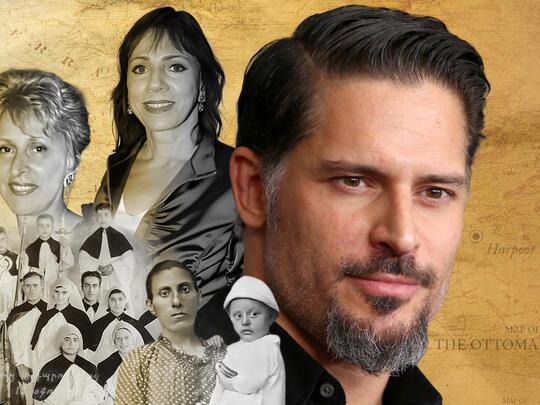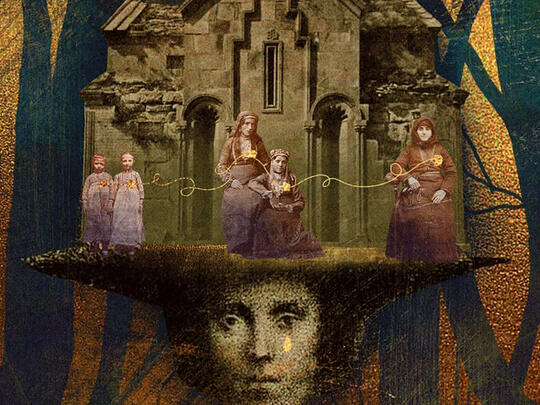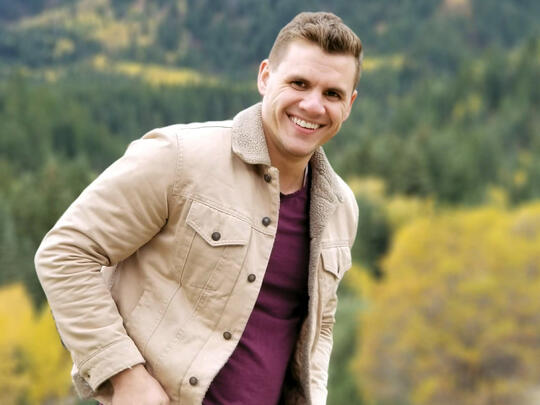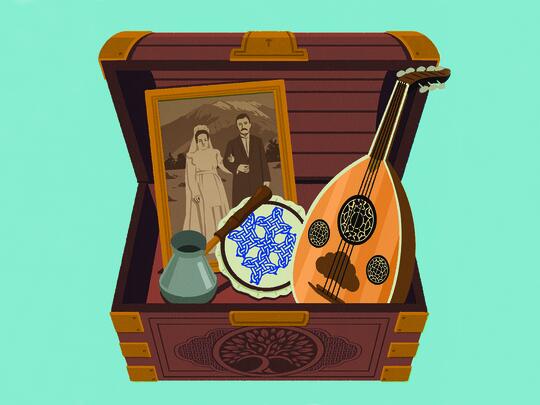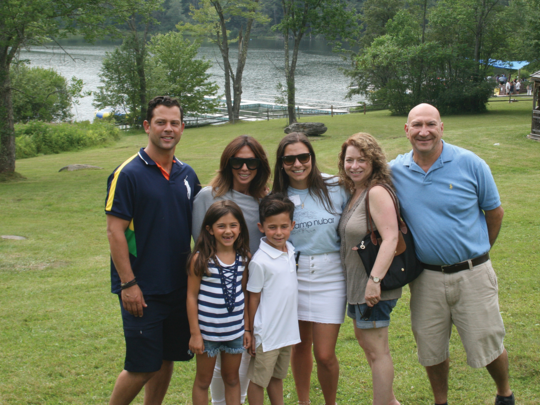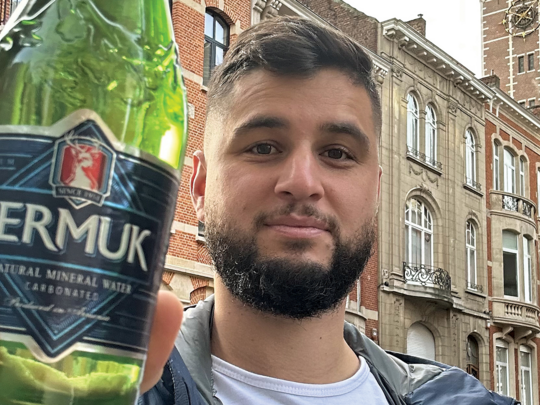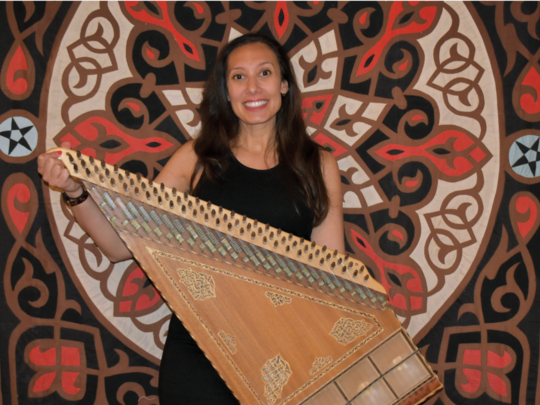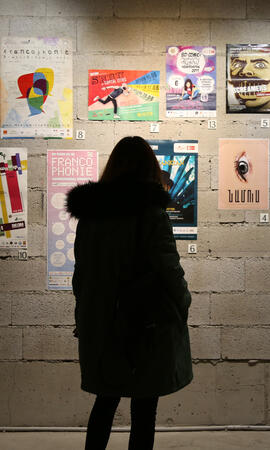In 2022, Very Reverend Father Mesrop Parsamyan became the 13th Primate of the Eastern Diocese of the Armen-ian Church of America, marking a new era of leadership at a time when the Armenian Diaspora is undergoing a fundamental shift in demographics. With each generation since the Armenian Genocide, the percentage of diasporans of mixed ethnicities, races and faiths continues to rise, raising burning questions about issues of identity, assimilation, and belonging in the 21st century context.
With his sterling theological credentials, wide-ranging experiences in parishes around the world, and his roots in the homeland, Fr. Mesrop is uniquely suited to talk about the influence of the Armenian Church on today’s Armenian identity.
Q: Thank you for taking the time to share your thoughts about what has long been the bedrock of Armenian identity—the Armenian Church. Can you first tell us how your background has informed your perspective on modern Armenian identity and the Church?
A: Yes, thank you for this opportunity to speak about this very important subject. I was born and raised in Armenia, and at the age of 22 moved to France to continue my studies in theology. Two years later, I was serving in the clergy, with various positions in Europe and the United States. You could say my ministry is going wherever there are Armenians—whether it’s in Belleville, Illinois; Strasbourg, Nice, Brussels, Marseille or Geneva. I’ve spent time serving the Armenians of Paris as well, and by this point, I am fluent in five languages.
I feel that I can go wherever there are Armenians, and that, for me, is a blessing. I am thankful to God for the chance to live and share my life with Armenians of all backgrounds. To know and understand the differences, the similarities, the challenges, the successes and the strength of our identity. And wherever I go, I see the resilience of our people. And this has made my own life more meaningful and more joyful, knowing that Armenians in the Diaspora are surviving and thriving since the Genocide.
And now, in the Eastern Diocese, I can bring all these experiences to my mission to create worldwide Armenian unity. You see, when we say Armenian identity, it’s not one identity just in Armenia, but it’s a worldwide reality. It is my task as a leader to bring the Armenians across the world together and create the Armenia that we dream about in the Diaspora.
But that is not the only mission. Another important goal of the Armenian Church is Hayabahbanootyun, which means to preserve Armenian identity in the Diaspora.
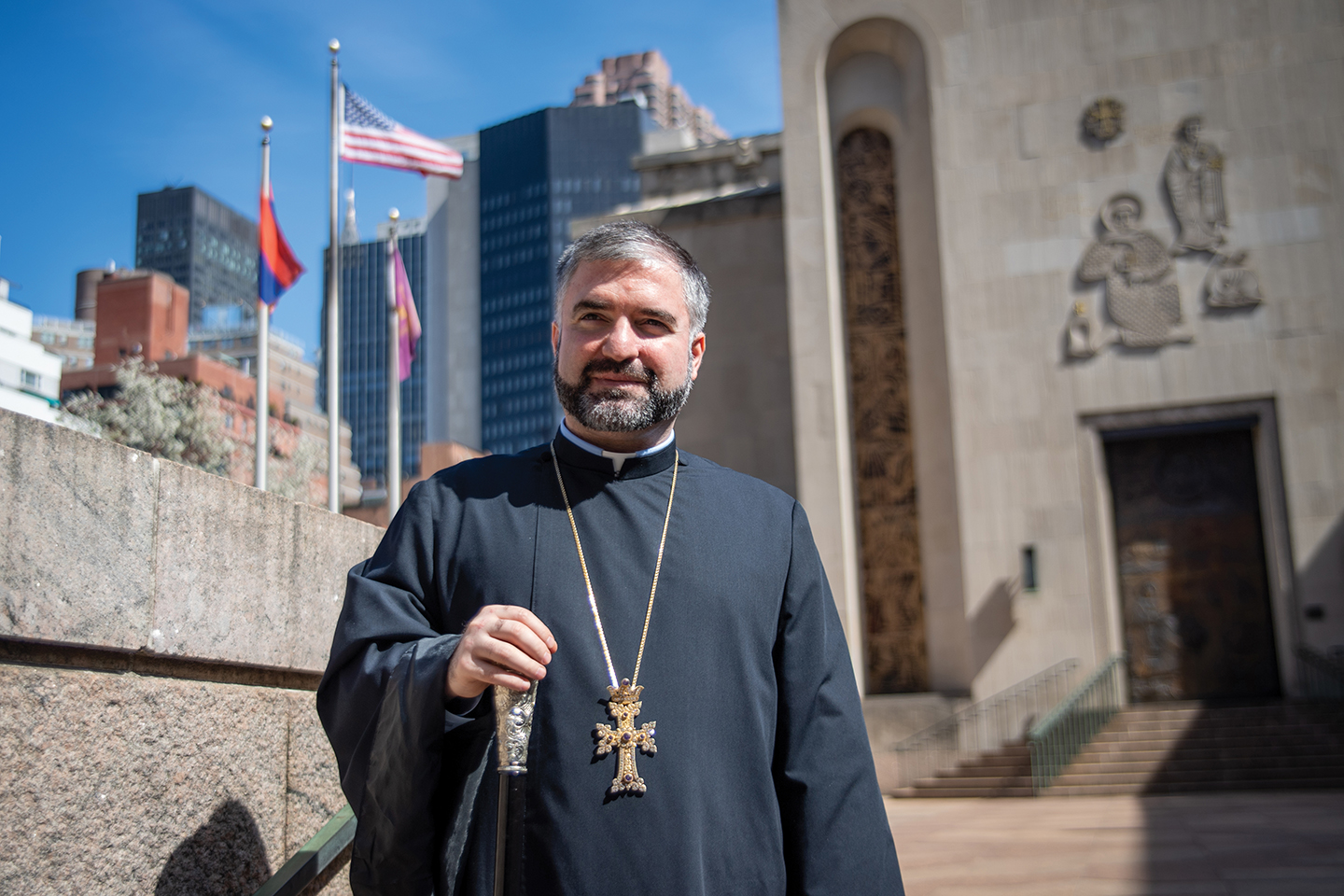
Q: Some say that the Church should focus only on the religious and spiritual realms of Armenian identity, but the cultural aspects can be left to other entities. Do you agree?
A: Of course we have different organizations that focus on culture, but they most always collaborate with the Church. One needs to look at the question differently. Yes, it is the main mission of the Church to preach the Gospel of our Lord Jesus Christ, but the Gospel is not independent from the culture. The Gospel is always centered in history, and today it is incorporated in the given culture. It is called “inculturation.” When the Armenian alphabet was invented in the fifth century, the good news was transferred into Armenian culture in the form of the Bible. This is when the inculturation process took place. Now, 16 centuries later, the Christian identity and Armenian identity are still one and the same. You cannot separate them. Despite the western idea of the separation of church and state, the Armenian Church and Armenian culture are indivisible.
In reality, the Gospel and Christian faith, from its inception until today, is not merely a kind of a knowledge. It’s not primarily something that we know about. It’s not a theory. Rather, it’s a way of living that is expressed in our everyday lives.
Look back to the foundation of this beautiful country of America. The Founding Fathers had a strong Christian background, Christian culture, and when you read the Constitution, the “birth certificate” of this country, and other documents as well as our currency, the Gospel values are present. So faith cannot be indifferent toward the culture, it embraces and it enriches the values, and it provides the moral values to develop culture, identity and history.
When Christ was incarnated, He transformed history. We have a BC and AD because that was a turning point in the human experience. We are now in Anno Domini, the year of the Lord, and it’s expressed in our everyday life, in culture, in everything. Today, our church’s mission and responsibility is to remind our people of this and offer these beautiful, rich, centuries-old traditions that reinforce the Armenian identity.
Q: Is this unity of religion and culture what differentiates Armenian Christianity from other Christian denominations?
A: For any identity, but especially for Armenian identity, we can distinguish five main aspects. The first is our historical cultural heritage dating from the fourth century as seen in our monasteries, churches and cathedrals. Then there is the religion of course. Next there is the Armenian language. The invention of the alphabet by Mesrop Mashtots enabled us to spread the good news through the Armenian-language Bible. There is also the connection to the land, the memory of the historical land, Armenia, Western Armenia, and Eastern Armenia. Even after losing our kingdom and independent state, the Church represented the people and tried to keep a presence on that sacred land through the decades until the rebirth of an independent Armenia. And finally, ethnicity, the blood lineage that contributes to identity. As for the ethnic aspect, when Armenians get married in the Armenian Church, they’re becoming part of our family, they’re in the blessing of the Church.
Keep in mind, though, that if somebody is Armenian, it doesn’t mean that all these five aspects must be present to qualify as an Armenian. These five attributes describe the idealized Armenian identity. By the way, we have very good Armenians who are not at all Armenian, or they don’t know about Armenian culture and history, but they have these connections. These are the “Armenians by Choice” and they are often the strongest Armenians. At the same time, there are atheist Armenians or agnostic Armenians who don’t believe in God, but they fully understand the extent of the Armenian cultural heritage.
When the Armenian alphabet was invented in the fifth century, the good news was transferred into Armenian culture in the form of the Bible. This is when the inculturation process took place. Now, 16 centuries later, the Christian identity and Armenian identity are still one and the same. You cannot separate them.
Q: How do you keep Church culture relevant in every generation?
A: We need to communicate our centuries-old traditions and truth in a new way in our society. We are doing this here at our Eastern Diocese through different means of communication, including virtual and digital.
However, first and foremost, to understand the culture of the church, Armenians should at least have a basic knowledge of the Gospels or Christian history. When you enter one of our churches and you listen to the sharagans (hymns) or you see a miniature illuminated manuscript, for example, to understand the meaning of that picture, you should at least have a knowledge of the Gospel. It’s the same as with western culture—you visit these magnificent cathedrals and museums, the Louvre or Metropolitan Museum. You behold these beautiful paintings. Yet, to appreciate their message, we need to know the stories behind the biblical figures depicted. The same is true about ancient Greek mythology. To understand the objects and images, you need a fundamental knowledge of what each god or goddess stands for.
I would encourage our people, whether they believe in God or not, to understand the scope of Armenian culture. To do that, they need to learn the basics of the Christian faith, which touches all aspects of Armenian identity, bringing them together and crystallizing that ideal image of the identity, as something to strive for.
I’m from Armenia, I’m the Primate of the Eastern Diocese, I studied in a seminary, I know the history, but I don’t know the whole history. So it’s a work in progress to learn the culture, the history, to understand the depth of that language or the connection to the land. As I said, these five aspects of identity are something we are striving to embrace. And the Church is there to help people make that connection with the motherland and in turn, the motherland to that historical cultural heritage, language, faith and so forth.
Q: How does assimilation interfere with developing an Armenian identity? In America, we have myriad cultural influences. How does Armenian church culture compete?
A: Of course, assimilation is a threat to our identity, but assimilation happens when our people are not aware of our rich Armenian heritage. In my pastoral ministry in Europe for over 10 years, and the eight years I have served in the United States, I realized that, when our people become aware of their rich Armenian identity, they are proud and they transmit this pride to the different aspects of identity. But when they are not aware, they try to hide their ethnic origins. They want to assimilate because they are afraid they won’t be accepted in the larger society.
But especially today, here in the United States and in Europe, minorities are trying to reverse this trend. There is a revival of rediscovering one’s ethnic identity. There are proud Hispanics, Latinos, African-Americans, and Asians.
Now it’s time for Armenians to rediscover our identity, the history, the richness of our artistic and scientific genius. Only then will they be proud of their identity. When I was a pastor in Belleville, Illinois, I made a presentation about Armenian ancient history. Afterward, one of the parishioners approached me. She was in tears and confessed to me, “Before I was scared, I didn’t know anything about Armenia, and I was ashamed to tell anyone that I’m Armenian. But now, when I see this thousand-year-old history of my people, I feel proud and want to go out and shout that I am Armenian.”
So, that’s the key, education and knowledge. When our people discover the treasures of their birthright, then they come forward. Otherwise, they are ashamed and they don’t transmit their heritage to their children. That’s when assimilation is complete.
Now it’s time for Armenians to rediscover our identity, the history, the richness of our artistic and scientific genius. Only then will they be proud of their identity.
Q: What about non-Bible related history, like the Armenian Genocide? Wouldn’t this very dark chapter play a great role in shaping our Armenian identity? Most every Armenian family narrative begins with the Genocide.
A: Good question. So, I first talked about the five aspects of Armenian identity, but there are two additional characteristics of Armenian identity, which are suffering and survival. Our history, is all about suffering, but somehow we survive every time. We refer to the first genocide of the beginning of 20th century, but we had other massacres in the Middle Ages, perpetrated by different tribes and nations.
Suffering is a characteristic of being Armenian. But, on the other hand, many other ancient civilizations have disappeared. You look at ancient maps and you see Armenia there. Today all the other civilizations have disappeared, but Armenia is still there. This speaks to the strength of our identity, our people. Somehow we survive all these trials and challenges of history.
However, the secret to this continuous survival is the knowledge of our history. When you embrace your past, you become part of the future. When Movses Khorenatsi of the fifth century wrote the History of the Armenians, he put together a chronicle to be passed down the generations. This too embodies the Armenian dream, the Armenian vision, the Armenian way. So, if we continue to embrace the past, we can create a future based on history that can remain relevant across the ages.
Q: What about part Armenians? Isn’t it easier to go with the majority culture that is more recognized in the social consciousness?
A: The answer is simple. We need to be successful. For example, we read about a celebrated Armenian in the mainstream papers or we see a soccer team making history. I remember in Europe, many proud Armenians would say “Wow, I am Armenian, it’s my team.” They identify when there’s success, because people want to be part of this success. And Armenians are successful not only for the sake of success, but to show the strength of our resilience—that we can survive through genocide and rise up to give back to humanity. We can win Nobel Prizes and invent COVID vaccines. I’m convinced that it is in our genes to survive calamities and hardships and go on to excel in whatever we do. So, succeeding is the flip side of the coin of suffering.
Q: How important is it to speak and read Armenian to retain a strong Armenian identity?
A: I would say language is a key to the full extent of the Armenian historical and cultural heritage, and to understanding the spirit, the soul of the people. But of course, in the Diaspora, Armenians, for different reasons, don’t know the language. Yet they carry this Armenian identity with them. So as a pastor, it has been part of my ministry to offer to teach Western Armenian.
Of course I know that I cannot teach anyone to speak Armenian fluently, but at least to give them a taste of the language and how to read the alphabet, our “secret language” that sets us apart from the rest. Then it’s up to the person to practice and keep learning.
Nowadays, people learn the languages which are trending or beneficial for them for different reasons, like Spanish and Chinese for business, or Italian or French for culture. But again, it’s up to the Church to show them the importance of Armenian and the riches it can unlock, once you can speak it.

Q: Some have observed that those who didn’t marry an Armenian or wed in an Armenian church still want their children to be baptized in the Church. Or those who have been out of the Armenian community for most of their lives still want their last rites performed by our church. What are the reasons, do you think?
A: I think that’s the inner call and connection to the Armenian identity, spirituality and tradition. Consciously or unconsciously, people yearn to be a part of their heritage, to carry out that timeless legacy. They want to pass it on to the next generation with baptism. Or, on their deathbed, to feel that they are not alone, that they are still belonging. Some want to feel that they belong to something greater, which is going to survive through the ages, because of our legacy for overcoming. When we are gone, our Armenian soul will continue for generations. They want to be a part of that journey, which lasts for centuries and will continue until the second coming of Christ.
I would encourage our people, whether they believe in God or not, to understand the scope of Armenian culture. To do that, they need to learn the basics of the Christian faith, which touches all aspects of Armenian identity, bringing them together and crystallizing that ideal image of the identity, as something to strive for.
Q: What are three common misconceptions about the Armenian Church that you would like to take this opportunity to clarify?
A: Armenians think that our church has dogmas, which is not true. The Armenian word is Vartabedootiun which means “teaching.” So, instead of forcing it, the church always teaches. The second misconception is that Armenians don’t read the Gospel or the Bible during worship, but when you look closely at our daily services and our prayers, every sentence is taken from the Bible with no exceptions. Not only do we read the Bible in our service, but we pray the Bible. The third misconception is that the Armenian Church is archaic, it’s historical, and it’s not relevant to our society, our daily life. But again, look closer and you will see they are so interconnected to our daily life. All our mental health issues, anxiety, stress, and psychological challenges are addressed. Long before the sciences, church fathers studied the human soul and they shared this knowledge.
Now we have that treasury of insight to share. We know it can help our people through their spiritual exercises and promote the values relevant to society.
I like this quote: “Tradition is not keeping the ashes, but keeping the flame alive.” So our church keeps that flame alive. From the fourth century until now, we see that transcendental connection to our ancestors, who prayed in the same language.


